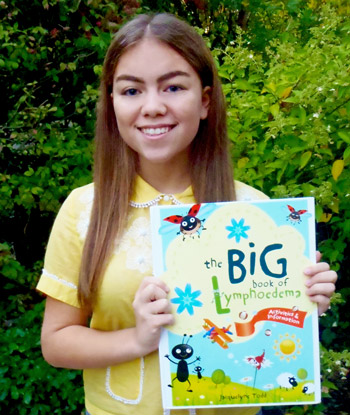TORONTO — Leora Nash, a 15-year-old student at the Anne and Max Tanenbaum Community Hebrew Academy of Toronto was diagnosed with primary lymphedema in her right leg when she was four.
“I had to receive special weekly massages that brought the swelling down, so I could wear a custom-made knee-high stocking,” Leora tells The CJN.
Few have heard of primary or secondary lymphedema, including those at risk for developing the condition. The majority of people diagnosed will have secondary lymphedema and are cancer survivors.
It is rare to have primary lymphedema, and even rarer to have pediatric primary lymphedema, like Leora.
Lymphedema is a chronic infection often associated with excessive swelling, because the lymphatic system fails to drain fluid, cells and protein away from tissues within the body. It is often a complication arising from the treatment of various cancers and melanoma.
Lymphedema affects some four to five million people in North America, including some 300,000 Canadians. If left untreated, there is a risk of loss of limb function, as well as chronic infection. The Lymphedema Association of Ontario receives no government funding.
Treatment consists of compression therapy, bandaging, pressure garments, skin care to prevent infection, and manual lymphatic drainage massage performed by a certified lymphedema therapist.
“I still remember the day Leora got the stocking – I was so worried she would hate wearing it – but she thought it was amazing! ‘It gives me super-powers,’ Leora said, jumping up and down. That was a big relief for me,” recalled Janice Goldberg, Leora’s mother.
“Leora began exhibiting episodes of pain starting at age six,” Goldberg said. “We noticed that she would have discomfort after a lot of walking or an increase in activity during family outings.
“At age eight, she had a week of increasing, unmanageable pain that resulted in an admission to Sick Kids’ Hospital for a lymphedema-related cellulitis infection. The episode triggered the development of neuropathic chronic pain in her foot. She was helped by the chronic pain team at Sick Kids and we also sought care for her at Boston Children’s Hospital.
“Over time, Leora learned to manage her pain using a toolbox of strategies. Her neuropathic pain dissipated and she was no longer affected as severely.”
When she was 12, Leora received a copy of The Big Book of Lymphoedema from England. “This book is for kids, and illustrates what lymphedema is with bright pictures and activities,” Leora said.
Today, “The Big Book for Kids” is an outreach program in collaboration with the Hospital for Sick Children’s department of rehabilitation services. The Big Book of Lymphoedema is provided to each newly diagnosed and follow-up patient to help then understand the changes that will happen to their body and prepare them to cope with this life-long condition.
On the last weekend of September, the Lymphedema Association of Ontario held its annual fundraising five-kilometre walk in five different cities across Ontario and raised almost $23,000 for research.
